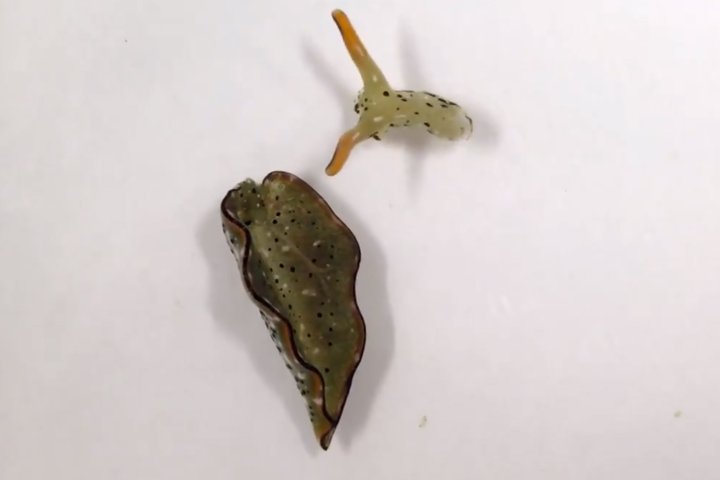
Scientists are losing their minds over a sea slug that will seemingly never lose its head — even after it loses its body.
Researchers on Monday announced that some sea slugs can regrow an entire body — including a heart — if their head remains intact, in a never-before-seen instance of regeneration.
The study was published in the journal Current Biology, along with video of a slug keeping calm and carrying on after its own decapitation.
Sacoglossan sea slugs don't mind losing their heads. Not only can the sea slugs elect to detach their heads and survive, but they can regrow a whole new body. Read more in @CurrentBiology https://t.co/7ueo5HL0Vn@NaraWomensUniv
Video: Sayaka Mitoh pic.twitter.com/oL5bh9psQ7— Cell Press (@CellPressNews) March 8, 2021
Doctoral student Sayaka Mitoh says she was studying Japanese sea slugs at Nara Women’s University when she noticed one crawling around on its head after effectively severing itself from its body. She soon saw a few others do the same thing, in what she describes as a “wonder of nature.”
“I was really surprised and shocked to see the head moving,” she told the New York Times.
The slug ultimately managed to regenerate its entire body within three weeks, defying Mitoh’s expectations that it would die without its vital organs.
Mitoh and Yoichi Yusa, an aquatic ecology professor, teamed up to study the phenomenon in detail. The cut the heads off 16 sea slugs and noticed that six of them started regenerating. Three of those six managed to fully regrow their bodies, and one even managed to grow two bodies in a row.
The two study authors say they saw the regeneration in two different species of Japanese sea slugs, Elysia marginata and Elysia atroviridis.
Read more:
Massive ‘space hurricane’ discovered swirling over the North Pole
They say the regeneration process is an intense version of autotomy, the process by which a creature will discard a body part to survive before regrowing it later. Some lizards have been known to do this with their tails, but scientists did not know that sea slugs could do the same thing with their bodies.
“We think that this is the most extreme case of autotomy,” Yusa said. “Some animals can autotomize their legs or appendages or tails, but no other animal shed their whole body.”
The discovery is surprising because scientists wouldn’t expect a 15-centimetre-long slug to be able to survive without a body, Canadian marine biologist Susan Anthony told The Associated Press.
Read more:
Scientists ‘shocked’ to find life in extreme depths under Antarctic ice
Yusa suspects the slugs are able to survive because of a rare ability to photosynthesize their food from sunlight and oxygen. The slugs gain this ability when they eat certain types of algae, allowing them to survive like a plant for about 10 days.
Yusa says the slug’s head likely starts photosynthesizing like a plant after decapitation, turning green and soaking it oxygen and sunlight until it can regrow its body. They likely developed the ability as a way to fight off parasites, Yusa suggested.
“We’ve known for a long time that sea slugs have regenerative capabilities, but this really goes beyond what we had thought,” Terry Gosliner, senior curator of invertebrate zoology at the California Academy of Science, told the Times.
Scientists hope the discovery will help them learn more about regeneration in nature and perhaps apply it to human medicine in the future.
However, researchers may need to put their heads together a few more times to figure out how it all works.
—With files from The Associated Press
© 2021 Global News, a division of Corus Entertainment Inc.
https://news.google.com/__i/rss/rd/articles/CBMiPmh0dHBzOi8vcTEwNy5jb20vbmV3cy83Njg2MjU0L3NlYS1zbHVnLWhlYWQtYm9keS1kZWNhcGl0YXRpb24v0gEA?oc=5
2021-03-09 20:58:55Z
52781424260420
Tidak ada komentar:
Posting Komentar